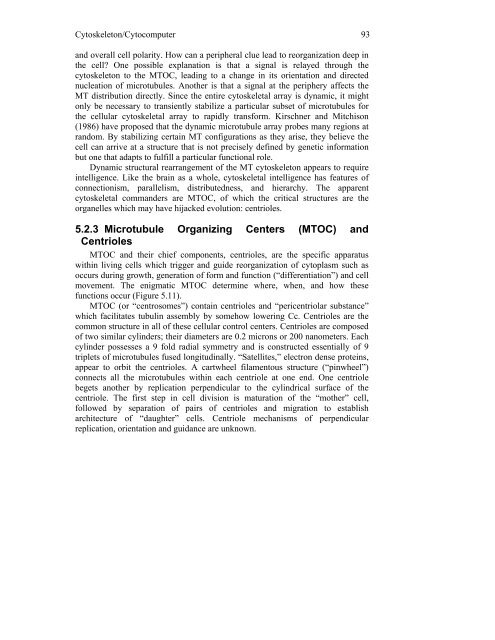ULTIMATE COMPUTING - Quantum Consciousness Studies
ULTIMATE COMPUTING - Quantum Consciousness Studies
ULTIMATE COMPUTING - Quantum Consciousness Studies
- No tags were found...
You also want an ePaper? Increase the reach of your titles
YUMPU automatically turns print PDFs into web optimized ePapers that Google loves.
Cytoskeleton/Cytocomputer 93<br />
and overall cell polarity. How can a peripheral clue lead to reorganization deep in<br />
the cell One possible explanation is that a signal is relayed through the<br />
cytoskeleton to the MTOC, leading to a change in its orientation and directed<br />
nucleation of microtubules. Another is that a signal at the periphery affects the<br />
MT distribution directly. Since the entire cytoskeletal array is dynamic, it might<br />
only be necessary to transiently stabilize a particular subset of microtubules for<br />
the cellular cytoskeletal array to rapidly transform. Kirschner and Mitchison<br />
(1986) have proposed that the dynamic microtubule array probes many regions at<br />
random. By stabilizing certain MT configurations as they arise, they believe the<br />
cell can arrive at a structure that is not precisely defined by genetic information<br />
but one that adapts to fulfill a particular functional role.<br />
Dynamic structural rearrangement of the MT cytoskeleton appears to require<br />
intelligence. Like the brain as a whole, cytoskeletal intelligence has features of<br />
connectionism, parallelism, distributedness, and hierarchy. The apparent<br />
cytoskeletal commanders are MTOC, of which the critical structures are the<br />
organelles which may have hijacked evolution: centrioles.<br />
5.2.3 Microtubule Organizing Centers (MTOC) and<br />
Centrioles<br />
MTOC and their chief components, centrioles, are the specific apparatus<br />
within living cells which trigger and guide reorganization of cytoplasm such as<br />
occurs during growth, generation of form and function (“differentiation”) and cell<br />
movement. The enigmatic MTOC determine where, when, and how these<br />
functions occur (Figure 5.11).<br />
MTOC (or “centrosomes”) contain centrioles and “pericentriolar substance”<br />
which facilitates tubulin assembly by somehow lowering Cc. Centrioles are the<br />
common structure in all of these cellular control centers. Centrioles are composed<br />
of two similar cylinders; their diameters are 0.2 microns or 200 nanometers. Each<br />
cylinder possesses a 9 fold radial symmetry and is constructed essentially of 9<br />
triplets of microtubules fused longitudinally. “Satellites,” electron dense proteins,<br />
appear to orbit the centrioles. A cartwheel filamentous structure (“pinwheel”)<br />
connects all the microtubules within each centriole at one end. One centriole<br />
begets another by replication perpendicular to the cylindrical surface of the<br />
centriole. The first step in cell division is maturation of the “mother” cell,<br />
followed by separation of pairs of centrioles and migration to establish<br />
architecture of “daughter” cells. Centriole mechanisms of perpendicular<br />
replication, orientation and guidance are unknown.






